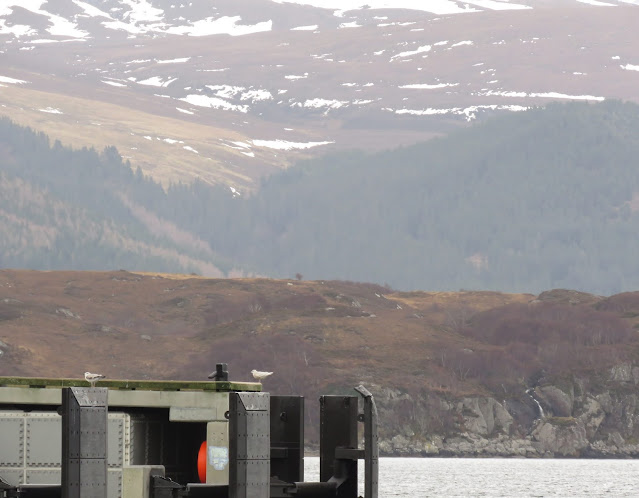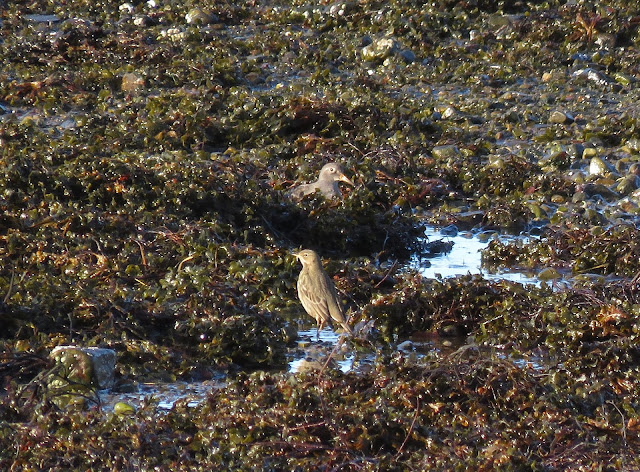Monday, February 22, 2021
Yesterday, we walked out to Loch Achall via the hill path and back down the quarry road. The bird list was pretty dire - one buzzard and a pair of pigeons (either rock doves or feral pigeons) seen, and a robin, a chaffinch, and a great tit heard singing or calling.
Today, hanging out the washing, I saw the crocuses - a splash of happy colour in dark sad times.
Later, I did a short, brisk walk round and was pleased to see that the godwit was still present. I didn't notice at the time that its head was tilted - maybe there was an eagle up there. Don't think so, though - the gulls and corvids would have been making a fuss.
Saturday, February 20, 2021
Yesterday: Greger had his first jab - and then we went for a leisurely stroll to the camp-site. The godwit was still there.
Today, Greger's a bit tired and headachy - possibly side effects of the vaccination; so I went for a walk alone and found the bar-tailed godwit still in the company of oystercatchers on the camp-site. I tried hard to see what they were feeding on, but they were too quick for me. Starlings are also feasting there, and I know they love leatherjackets. The Iceland gull was far out on the quayside so I made a not-very-good landscape shot of it.
Thursday, February 18, 2021
On Shore Street we were treated to good views of an Iceland gull cruising round the harbour. As we made our way past the point I scanned the oystercatchers on the beach ahead - but the bar-tailed godwit must have been foraging alone on the camp-site because suddenly it was in the air and flying away to the north.
It soon returned and joined the oystercatchers on the beach, although as we walked on they all flew up onto the grass.
It began to rain as we headed home, where we found two interesting items in the post. First there was my new driving licence - which I applied for, online, just a couple of days ago! Good service. Not only that, but it was free (thanks to my advanced age, presumably). Then there was a customised OS Landranger map that Greger had ordered, with my photo of him up the hill on the front.
Wednesday, February 17, 2021
I was determined to get out for a walk today despite high winds and rain. Greger gave me a lift down to the front - and as I got out of the car, it stopped raining and the sun came out.
Looking back at the ferry from West Shore Street I saw an Iceland gull land briefly - probably the same one I snapped at the spit.
I clicked off a shot as it flew away and was surprised to see another white winger in the photo as I didn't notice it at the time. I suppose it could be the old viking gull.
A handful of small birds flying up the loch right out in the middle were not waders, but passerines. No idea what they were - possibly rock or even meadow pipits, maybe. At least 50 greylag geese were just offshore, three curlews were dozing at the water's edge, and a bunch of oystercatchers were busily feeding in the now-soft earth of the camp-site. With them was a bar-tailed godwit - my first in Ullapool.
In winter, bar-tailed godwits can be seen in numbers at Udale Bay - but the east coast is out of bounds at the moment, which made this one extra special.
It's a pity that some choose not to follow the rules, because it potentially affects us all. Twitchers who drove miles and miles to see a northern mocking bird in Devon are just a few of the nuisances who think they're not involved in what's going on in the world. On twitter, someone thinks it "ridiculous, police wasting time on birders". What?! Twerp.
Thursday, February 11, 2021
When the temperature drops below freezing, the calor gas tends to seize up - and I can't make my porridge! Greger just breathes on the valve to warm it up but I find that makes me feel light-headed, and in any case, the hairdryer is faster.
The medical centre rang yesterday after we'd got back from our walk - and this afternoon at 4.40 I went over and received my first Covid jab. The second should be given in 9 to 12 weeks' time. Maybe, just maybe, by the time spring comes, we'll be out of lockdown. Here's hoping.
Wednesday, February 10, 2021
We decided to try again to get up a small local hill. The zigzag path up Ullapool Hill was slightly slippery, and then we were crossing moorland towards Maol Chalaisgeig (height 301m above sea level).
The hill felt wild enough today in near freezing conditions, but the seat near the top is a reminder that this is a popular viewpoint in summer.
The little cairn marks the summit, overlooking Loch Achall.
We lingered for a while enjoying the stillness and the views. Greger confidently identified these as hare tracks; thrilling to think we could see mountain hares this close to home!
To the south was a panorama of mountains including the Fannichs, with Sgurr Mor in the centre - a mini Matterhorn.
Dropping back down to the junction of paths, we decided to turn right and walk out to Loch Achall, coming back down the quarry road and so home. This path (we should have remembered from a few days ago) was much worse than the hill. Except in very dry spells, this is a wet path (the site later in the year of frogspawn and newt-mating puddles) and this water had frozen at the beginning of the cold spell. Snow had fallen since, but only a thin layer, so when Greger stepped on it his foot slid away immediately. I did better thanks to some studded rubber harnesses for my boots that he'd bought for me - sort of pretend crampons. They're very difficult to put on, so we did that at home and I had to clatter along on the snow-less road at the beginning and end of the walk - but they were very effective up the hill.
We heard a sound and I stopped, sure it was a bird - and we heard it once again. It was a hollow sound, and was quite possibly water - but although we waited it wasn't heard again. Back at home, I played a clip of Jack snipe singing from the zenocanto website; and Greger agreed that what we'd heard did sound like a shortened version of this. But Jack snipe don't breed in the UK, so would they sing here? Coincidentally, common snipe were reported on the Assynt wildlife site today.
Thursday, February 04, 2021
The Iceland gull brightened up a windy, rain-spitty sort of day, landing on the river and then emerging onto land to do a bit of preening.
Yesterday, we walked the same round and saw an otter - and a song thrush. Song thrushes are often on the beach at the moment, probably searching the seaweed for food along with rock pipits.
Also yesterday: As we made our way along the bull park a flock of birds went over heading north - and too fast for me to get a picture. "Pigeons?" I wondered - but Greger said they didn't strike him as pigeons. Another possibility would be golden plover; we hardly saw any last year and the idea that they are on the move already makes the heart skip a beat.
Tuesday, February 02, 2021
The Met Office shows the wind today as ESE - and it swept icily down the loch, making the small boats anchored off Shore Street dance wildly on a roughish sea. My eyes were watering as I fought my way out onto the quayside and it was difficult to hold the camera still with gloveless hands, but it was worth it for my first Iceland gull of the year.
Thankfully pulling my gloves back on, I carried on to the camp-site - noting that the ferry was still in. Perhaps it's not sailing today because of the weather.
At least three rock pipits were also foraging along the sides of the trench.
As I made my way out to the spit, a flock of waders that looked like ringed plovers flew across the river from the golf course and began to wash and preen on the grassy tip of the spit. Using the gorse bushes as cover I got close enough to confirm that the purple sandpiper was still present.
Continuing round the spit, I noted a bunch of gulls on the gravelly ridges that were being exposed by the falling tide. They took no notice of me so I was surprised, as I walked on, when they all went up in the air - and here's where my birding brain failed to kick into gear. The sky was full of gulls and instead of looking for what might have disturbed them (apart from a quick scan of the ground) I searched for another white-winger as they went over; and then more gulls were rising from the tip of the spit where the waders were. These went up more urgently and bunched together with a clamour - and suddenly they were all coming my way with a huge dark shape in their midst. A white-tailed sea eagle!
The eagle was flying low, but as it gained height the gulls fell away; and it came towards me before, I suppose, clocking my presence and turning back to the loch. Luckily I caught the tail in the second picture, showing that the eagle was an immature bird.
This was an exciting few minutes, but I reflected afterwards that the eagle might have been flying low because of the bitter wind, and coming close in to the village because it was desperate for food.
Monday, February 01, 2021
As the tide went out, a purple sandpiper foraged in seaweedy pools at the mouth of the Ullapool river.
A handful of gulls were hanging round the harbour, crying peevishly as they waited to see what they could scavenge; but this one was catching its own food. I managed just one poor shot before the gull flew off with its prize.




































